Marie-Eve VAL
@val-meve.bsky.social
Microbiologist, plasmid biology, genome maintenance, DNA replication, Vibrio, Institut Pasteur - Paris
Reposted by Marie-Eve VAL
Reposted by Marie-Eve VAL
Did you know most 'complete' Streptomyces genomes are missing their telomeres?
Thanks to David and Tues hard work, we now have a new tool to recover them!
A pleasure to be part of a team. :)
🦠🧪💻 #microsky
Thanks to David and Tues hard work, we now have a new tool to recover them!
A pleasure to be part of a team. :)
🦠🧪💻 #microsky
Bacterial telomeres are common, just not so much in RefSeq 'complete' genomes. But they can be added by the new tool David Faurdal wrote. I am thrilled to see this out as a preprint here: www.biorxiv.org/content/10.1... @tilmweber.bsky.social @thombooth.bsky.social

October 24, 2025 at 1:53 PM
Did you know most 'complete' Streptomyces genomes are missing their telomeres?
Thanks to David and Tues hard work, we now have a new tool to recover them!
A pleasure to be part of a team. :)
🦠🧪💻 #microsky
Thanks to David and Tues hard work, we now have a new tool to recover them!
A pleasure to be part of a team. :)
🦠🧪💻 #microsky
Reposted by Marie-Eve VAL
Thrilled to share our multidisiplinary work on how genome-wide DNA bridging by H-NS reshapes the stationary phase bacterial nucleoid and affects the transcriptional landscape. With Xindan Wang and @meyerroc.bsky.social
www.biorxiv.org/content/10.1...
www.biorxiv.org/content/10.1...

October 21, 2025 at 10:01 AM
Thrilled to share our multidisiplinary work on how genome-wide DNA bridging by H-NS reshapes the stationary phase bacterial nucleoid and affects the transcriptional landscape. With Xindan Wang and @meyerroc.bsky.social
www.biorxiv.org/content/10.1...
www.biorxiv.org/content/10.1...
Reposted by Marie-Eve VAL
Chromosome replication and cell division cycles are not synchronized in Staphylococcus aureus, with cells exhibiting two segregated origins of replication at the start of the cell cycle
#bacteria #microbiology
#bacteria #microbiology

Chromosome segregation dynamics during the cell cycle of Staphylococcus aureus - Nature Communications
Our understanding of chromosome organization and dynamics in spherical bacteria, such as Staphylococcus aureus, remains limited. Here, the authors show that chromosome replication and cell division cycles are not synchronized in S. aureus, with cells exhibiting two segregated origins of replication at the start of the cell cycle.
bit.ly
October 21, 2025 at 2:51 PM
Chromosome replication and cell division cycles are not synchronized in Staphylococcus aureus, with cells exhibiting two segregated origins of replication at the start of the cell cycle
#bacteria #microbiology
#bacteria #microbiology
Reposted by Marie-Eve VAL
Phages evolve fast, or do they?
In oysters, some stay identical for years.
With >1,200 phages & 600 Vibrio genomes, we reveal long-term stability and new mobile elements.
Proud of this collaborative work across our teams (Roscoff-UdeM and @epcrocha.bsky.social www.biorxiv.org/cgi/content/...
In oysters, some stay identical for years.
With >1,200 phages & 600 Vibrio genomes, we reveal long-term stability and new mobile elements.
Proud of this collaborative work across our teams (Roscoff-UdeM and @epcrocha.bsky.social www.biorxiv.org/cgi/content/...

Ecological constraints foster both extreme viral-host lineage stability and mobile element diversity in a marine community
Phages are typically viewed as very rapidly evolving biological entities. Little is known, however, about whether and how phages can establish long-term genetic stability. We addressed this eco-evolut...
www.biorxiv.org
October 12, 2025 at 9:16 PM
Phages evolve fast, or do they?
In oysters, some stay identical for years.
With >1,200 phages & 600 Vibrio genomes, we reveal long-term stability and new mobile elements.
Proud of this collaborative work across our teams (Roscoff-UdeM and @epcrocha.bsky.social www.biorxiv.org/cgi/content/...
In oysters, some stay identical for years.
With >1,200 phages & 600 Vibrio genomes, we reveal long-term stability and new mobile elements.
Proud of this collaborative work across our teams (Roscoff-UdeM and @epcrocha.bsky.social www.biorxiv.org/cgi/content/...
Reposted by Marie-Eve VAL
How do SMC complexes load onto DNA to get ready for loop extrusion?
@roisnehamelinf.bsky.social & co discovered that Wadjet, an SMC complex involved in bacterial DNA immunity, performs some impressive molecular gymnastics 🤸♂️🤸♂️🤸♂️.
Check out the new paper: www.cell.com/molecular-ce...
@roisnehamelinf.bsky.social & co discovered that Wadjet, an SMC complex involved in bacterial DNA immunity, performs some impressive molecular gymnastics 🤸♂️🤸♂️🤸♂️.
Check out the new paper: www.cell.com/molecular-ce...

October 9, 2025 at 2:43 PM
How do SMC complexes load onto DNA to get ready for loop extrusion?
@roisnehamelinf.bsky.social & co discovered that Wadjet, an SMC complex involved in bacterial DNA immunity, performs some impressive molecular gymnastics 🤸♂️🤸♂️🤸♂️.
Check out the new paper: www.cell.com/molecular-ce...
@roisnehamelinf.bsky.social & co discovered that Wadjet, an SMC complex involved in bacterial DNA immunity, performs some impressive molecular gymnastics 🤸♂️🤸♂️🤸♂️.
Check out the new paper: www.cell.com/molecular-ce...
Reposted by Marie-Eve VAL
Finally out, such an awesome piece of work, very proud of this one: www.cell.com/cell-systems... #MicroSky
October 4, 2025 at 8:48 AM
Finally out, such an awesome piece of work, very proud of this one: www.cell.com/cell-systems... #MicroSky
Reposted by Marie-Eve VAL
So excited our antibiotic potentiation story is out 🤩 Led by the extraordinary @manonlang.bsky.social with @fox-science.bsky.social & @amazeld.bsky.social +amazing collaborators @immunobladder.bsky.social @imaneelmeouche.bsky.social 🦠 We believe it can make a difference in #AMR infections!

Uridine as a potentiator of aminoglycosides through activation of carbohydrate transporters
Uridine boosts aminoglycoside treatment efficiency against antibiotic-susceptible as well as antibiotic-resistant E. coli strains.
www.science.org
September 6, 2025 at 9:35 AM
So excited our antibiotic potentiation story is out 🤩 Led by the extraordinary @manonlang.bsky.social with @fox-science.bsky.social & @amazeld.bsky.social +amazing collaborators @immunobladder.bsky.social @imaneelmeouche.bsky.social 🦠 We believe it can make a difference in #AMR infections!
Reposted by Marie-Eve VAL
🚨 New preprint! 🧬
𝐏𝐡𝐚𝐠𝐞-𝐩𝐥𝐚𝐬𝐦𝐢𝐝𝐬 (𝐏-𝐏𝐬) are fascinating elements: both 𝐭𝐞𝐦𝐩𝐞𝐫𝐚𝐭𝐞 𝐩𝐡𝐚𝐠𝐞𝐬 and 𝐩𝐥𝐚𝐬𝐦𝐢𝐝𝐬 ➡️ tricky to detect.
We present 𝐭𝐲𝐏𝐏𝐢𝐧𝐠 — the first 𝐢𝐝𝐞𝐧𝐭𝐢𝐟𝐢𝐜𝐚𝐭𝐢𝐨𝐧 𝐚𝐧𝐝 𝐜𝐥𝐚𝐬𝐬𝐢𝐟𝐢𝐜𝐚𝐭𝐢𝐨𝐧 𝐭𝐨𝐨𝐥 🛠️designed specifically for P-Ps:
✅ Accurate
✅ Sensitive
✅ Easy to use
📖 www.biorxiv.org/content/10.1...
𝐏𝐡𝐚𝐠𝐞-𝐩𝐥𝐚𝐬𝐦𝐢𝐝𝐬 (𝐏-𝐏𝐬) are fascinating elements: both 𝐭𝐞𝐦𝐩𝐞𝐫𝐚𝐭𝐞 𝐩𝐡𝐚𝐠𝐞𝐬 and 𝐩𝐥𝐚𝐬𝐦𝐢𝐝𝐬 ➡️ tricky to detect.
We present 𝐭𝐲𝐏𝐏𝐢𝐧𝐠 — the first 𝐢𝐝𝐞𝐧𝐭𝐢𝐟𝐢𝐜𝐚𝐭𝐢𝐨𝐧 𝐚𝐧𝐝 𝐜𝐥𝐚𝐬𝐬𝐢𝐟𝐢𝐜𝐚𝐭𝐢𝐨𝐧 𝐭𝐨𝐨𝐥 🛠️designed specifically for P-Ps:
✅ Accurate
✅ Sensitive
✅ Easy to use
📖 www.biorxiv.org/content/10.1...

Efficient detection and typing of phage-plasmids
Phage-plasmids are temperate phages that replicate as plasmids during lysogeny. Despite their high diversity, they carry genes similar to phages and plasmids. This leads to gene exchanges, and to the ...
www.biorxiv.org
September 3, 2025 at 1:03 PM
🚨 New preprint! 🧬
𝐏𝐡𝐚𝐠𝐞-𝐩𝐥𝐚𝐬𝐦𝐢𝐝𝐬 (𝐏-𝐏𝐬) are fascinating elements: both 𝐭𝐞𝐦𝐩𝐞𝐫𝐚𝐭𝐞 𝐩𝐡𝐚𝐠𝐞𝐬 and 𝐩𝐥𝐚𝐬𝐦𝐢𝐝𝐬 ➡️ tricky to detect.
We present 𝐭𝐲𝐏𝐏𝐢𝐧𝐠 — the first 𝐢𝐝𝐞𝐧𝐭𝐢𝐟𝐢𝐜𝐚𝐭𝐢𝐨𝐧 𝐚𝐧𝐝 𝐜𝐥𝐚𝐬𝐬𝐢𝐟𝐢𝐜𝐚𝐭𝐢𝐨𝐧 𝐭𝐨𝐨𝐥 🛠️designed specifically for P-Ps:
✅ Accurate
✅ Sensitive
✅ Easy to use
📖 www.biorxiv.org/content/10.1...
𝐏𝐡𝐚𝐠𝐞-𝐩𝐥𝐚𝐬𝐦𝐢𝐝𝐬 (𝐏-𝐏𝐬) are fascinating elements: both 𝐭𝐞𝐦𝐩𝐞𝐫𝐚𝐭𝐞 𝐩𝐡𝐚𝐠𝐞𝐬 and 𝐩𝐥𝐚𝐬𝐦𝐢𝐝𝐬 ➡️ tricky to detect.
We present 𝐭𝐲𝐏𝐏𝐢𝐧𝐠 — the first 𝐢𝐝𝐞𝐧𝐭𝐢𝐟𝐢𝐜𝐚𝐭𝐢𝐨𝐧 𝐚𝐧𝐝 𝐜𝐥𝐚𝐬𝐬𝐢𝐟𝐢𝐜𝐚𝐭𝐢𝐨𝐧 𝐭𝐨𝐨𝐥 🛠️designed specifically for P-Ps:
✅ Accurate
✅ Sensitive
✅ Easy to use
📖 www.biorxiv.org/content/10.1...
Reposted by Marie-Eve VAL
🌎👩🔬 For 15+ years biology has accumulated petabytes (million gigabytes) of🧬DNA sequencing data🧬 from the far reaches of our planet.🦠🍄🌵
Logan now democratizes efficient access to the world’s most comprehensive genetics dataset. Free and open.
doi.org/10.1101/2024...
Logan now democratizes efficient access to the world’s most comprehensive genetics dataset. Free and open.
doi.org/10.1101/2024...

September 3, 2025 at 8:39 AM
🌎👩🔬 For 15+ years biology has accumulated petabytes (million gigabytes) of🧬DNA sequencing data🧬 from the far reaches of our planet.🦠🍄🌵
Logan now democratizes efficient access to the world’s most comprehensive genetics dataset. Free and open.
doi.org/10.1101/2024...
Logan now democratizes efficient access to the world’s most comprehensive genetics dataset. Free and open.
doi.org/10.1101/2024...
Reposted by Marie-Eve VAL
At last ! A tool specifically for phage-plasmid hunters. Check tyPPing by @karinailchenko.bsky.social and @eugenpfeifer.bsky.social
🚨 New preprint! 🧬
𝐏𝐡𝐚𝐠𝐞-𝐩𝐥𝐚𝐬𝐦𝐢𝐝𝐬 (𝐏-𝐏𝐬) are fascinating elements: both 𝐭𝐞𝐦𝐩𝐞𝐫𝐚𝐭𝐞 𝐩𝐡𝐚𝐠𝐞𝐬 and 𝐩𝐥𝐚𝐬𝐦𝐢𝐝𝐬 ➡️ tricky to detect.
We present 𝐭𝐲𝐏𝐏𝐢𝐧𝐠 — the first 𝐢𝐝𝐞𝐧𝐭𝐢𝐟𝐢𝐜𝐚𝐭𝐢𝐨𝐧 𝐚𝐧𝐝 𝐜𝐥𝐚𝐬𝐬𝐢𝐟𝐢𝐜𝐚𝐭𝐢𝐨𝐧 𝐭𝐨𝐨𝐥 🛠️designed specifically for P-Ps:
✅ Accurate
✅ Sensitive
✅ Easy to use
📖 www.biorxiv.org/content/10.1...
𝐏𝐡𝐚𝐠𝐞-𝐩𝐥𝐚𝐬𝐦𝐢𝐝𝐬 (𝐏-𝐏𝐬) are fascinating elements: both 𝐭𝐞𝐦𝐩𝐞𝐫𝐚𝐭𝐞 𝐩𝐡𝐚𝐠𝐞𝐬 and 𝐩𝐥𝐚𝐬𝐦𝐢𝐝𝐬 ➡️ tricky to detect.
We present 𝐭𝐲𝐏𝐏𝐢𝐧𝐠 — the first 𝐢𝐝𝐞𝐧𝐭𝐢𝐟𝐢𝐜𝐚𝐭𝐢𝐨𝐧 𝐚𝐧𝐝 𝐜𝐥𝐚𝐬𝐬𝐢𝐟𝐢𝐜𝐚𝐭𝐢𝐨𝐧 𝐭𝐨𝐨𝐥 🛠️designed specifically for P-Ps:
✅ Accurate
✅ Sensitive
✅ Easy to use
📖 www.biorxiv.org/content/10.1...

Efficient detection and typing of phage-plasmids
Phage-plasmids are temperate phages that replicate as plasmids during lysogeny. Despite their high diversity, they carry genes similar to phages and plasmids. This leads to gene exchanges, and to the ...
www.biorxiv.org
September 3, 2025 at 2:00 PM
At last ! A tool specifically for phage-plasmid hunters. Check tyPPing by @karinailchenko.bsky.social and @eugenpfeifer.bsky.social
Reposted by Marie-Eve VAL
New preprint from the group: @lucydillon.bsky.social analysis of 16,000+ genomes finds Bacteria cannot combine certain resistance genes as they are mutually exclusive, forcing them down incompatible evolutionary paths.
biorxiv.org/content/10.1101/2025.08.20.671315v1
@jomcinerney.bsky.social
biorxiv.org/content/10.1101/2025.08.20.671315v1
@jomcinerney.bsky.social

Genomic constraints shape the evolution of alternative routes to drug resistance in prokaryotes.
Background: Variation within the prokaryotic pangenome is not random, and natural selection that favours particular combinations of genes appears to dominate over random drift. What is less clear is w...
biorxiv.org
August 22, 2025 at 10:38 AM
New preprint from the group: @lucydillon.bsky.social analysis of 16,000+ genomes finds Bacteria cannot combine certain resistance genes as they are mutually exclusive, forcing them down incompatible evolutionary paths.
biorxiv.org/content/10.1101/2025.08.20.671315v1
@jomcinerney.bsky.social
biorxiv.org/content/10.1101/2025.08.20.671315v1
@jomcinerney.bsky.social
Reposted by Marie-Eve VAL
I’m excited that the work by Diego Ramirez and Lei Yin is out, where they gained several key insights into what provides the force underlying bacterial cell division doi.org/10.1101/2025....
To divide, cells must first bend the membrane inward, a process that’s energetically expensive
To divide, cells must first bend the membrane inward, a process that’s energetically expensive

The interplay of membrane tension and FtsZ filament condensation on the initiation and progression of cell division in B. subtilis
The first step of cell division is deforming the planar cell membrane inward towards the cytoplasm. As deforming membranes is energetically costly, biology has developed various protein systems to acc...
doi.org
May 20, 2025 at 5:17 PM
I’m excited that the work by Diego Ramirez and Lei Yin is out, where they gained several key insights into what provides the force underlying bacterial cell division doi.org/10.1101/2025....
To divide, cells must first bend the membrane inward, a process that’s energetically expensive
To divide, cells must first bend the membrane inward, a process that’s energetically expensive
Reposted by Marie-Eve VAL
Our paper “Genetic determinants of pOXA-48 plasmid maintenance and propagation in Escherichia coli” is now online in @natcomms.nature.com ✨
👉 www.nature.com/articles/s41...
@cnrs-rhoneauvergne.bsky.social @mmsb-lyon.bsky.social
👉 www.nature.com/articles/s41...
@cnrs-rhoneauvergne.bsky.social @mmsb-lyon.bsky.social

Genetic determinants of pOXA-48 plasmid maintenance and propagation in Escherichia coli - Nature Communications
pOXA-48 plasmids have emerged as key vectors of carbapenem resistance within Enterobacteriaceae. In this study, the authors use a transposon sequencing (Tn-seq) approach to identify genetic determinan...
www.nature.com
August 20, 2025 at 3:19 PM
Our paper “Genetic determinants of pOXA-48 plasmid maintenance and propagation in Escherichia coli” is now online in @natcomms.nature.com ✨
👉 www.nature.com/articles/s41...
@cnrs-rhoneauvergne.bsky.social @mmsb-lyon.bsky.social
👉 www.nature.com/articles/s41...
@cnrs-rhoneauvergne.bsky.social @mmsb-lyon.bsky.social
Reposted by Marie-Eve VAL
This work is finally published! 🥳🧬
Plasmids are associated with very variable fitness costs in their different bacterial hosts. But, what is the contribution of each of the plasmid-genes in these host-specific effects? Study led by
@jorgesastred.bsky.social, @sanmillan.bsky.social and myself! 1/14
Plasmids are associated with very variable fitness costs in their different bacterial hosts. But, what is the contribution of each of the plasmid-genes in these host-specific effects? Study led by
@jorgesastred.bsky.social, @sanmillan.bsky.social and myself! 1/14
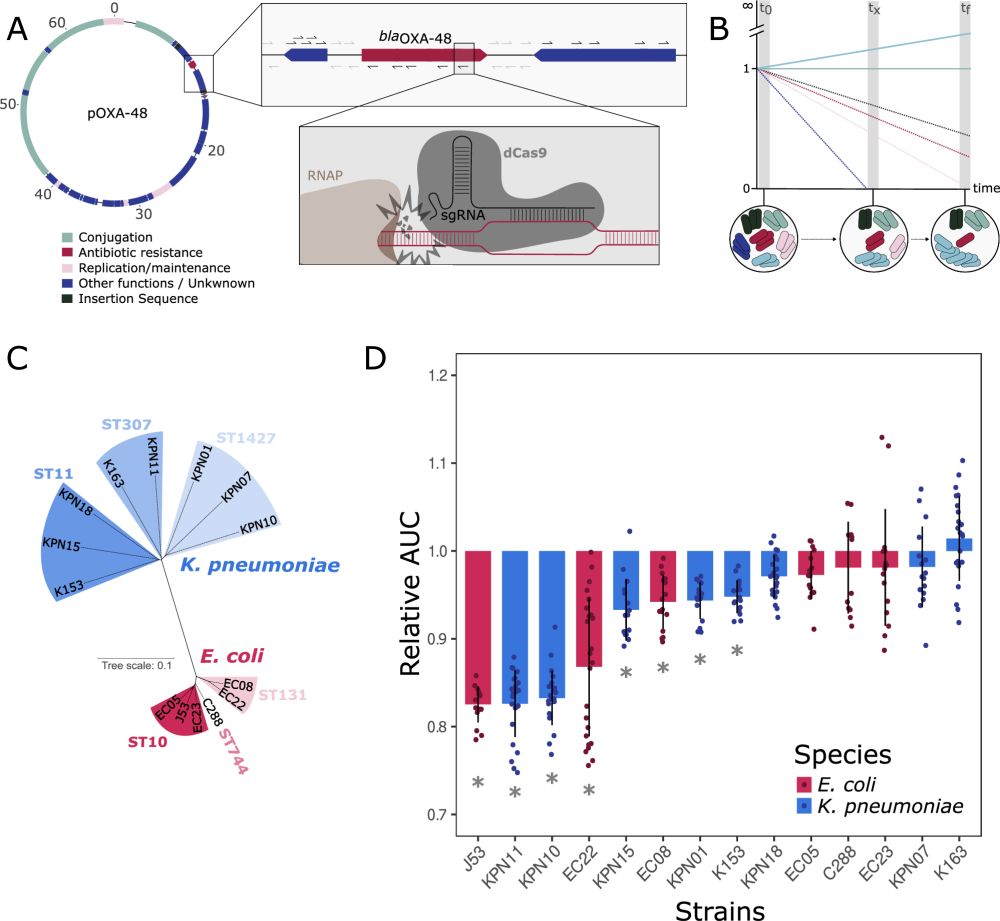
Dissecting pOXA-48 fitness effects in clinical Enterobacterales using plasmid-wide CRISPRi screens
Nature Communications - This study investigates the effects of the carbapenem resistance plasmid pOXA-48 in clinical enterobacteria. Using CRISPRi screens, the authors revealed that the...
rdcu.be
August 20, 2025 at 1:25 PM
This work is finally published! 🥳🧬
Plasmids are associated with very variable fitness costs in their different bacterial hosts. But, what is the contribution of each of the plasmid-genes in these host-specific effects? Study led by
@jorgesastred.bsky.social, @sanmillan.bsky.social and myself! 1/14
Plasmids are associated with very variable fitness costs in their different bacterial hosts. But, what is the contribution of each of the plasmid-genes in these host-specific effects? Study led by
@jorgesastred.bsky.social, @sanmillan.bsky.social and myself! 1/14
#microsky In this review, we summarize the current literature across bacterial phyla on large extrachromosomal replicons. Current Opinion in Microbiology: doi.org/10.1016/j.mi....
August 20, 2025 at 3:58 PM
#microsky In this review, we summarize the current literature across bacterial phyla on large extrachromosomal replicons. Current Opinion in Microbiology: doi.org/10.1016/j.mi....
Reposted by Marie-Eve VAL
For those who love bacterial replicons, The ultimate review, from our lab, signed by the master of their evolution.
@val-meve.bsky.social www.sciencedirect.com/science/arti...
@val-meve.bsky.social www.sciencedirect.com/science/arti...

Taming wild replicons: evolution and domestication of large extrachromosomal replicons
Bacterial genomes often contain extrachromosomal replicons (ERs), ranging from small, mobile plasmids to large, stably inherited elements, such as meg…
www.sciencedirect.com
August 20, 2025 at 10:28 AM
For those who love bacterial replicons, The ultimate review, from our lab, signed by the master of their evolution.
@val-meve.bsky.social www.sciencedirect.com/science/arti...
@val-meve.bsky.social www.sciencedirect.com/science/arti...
Reposted by Marie-Eve VAL
A paper in Nature Microbiology reports that the use of AI to mine proteomes of archaea led to the discovery of archaeasins, antimicrobials that kill drug-resistant bacteria in laboratory and animal models, offering a promising source of future antibiotics. #medsky 🧪

Deep learning reveals antibiotics in the archaeal proteome - Nature Microbiology
Use of artificial intelligence to mine proteomes of archaea led to the discovery of archaeasins, antimicrobials that kill drug-resistant bacteria in laboratory and animal models, offering a promising source of future antibiotics.
go.nature.com
August 16, 2025 at 4:32 PM
A paper in Nature Microbiology reports that the use of AI to mine proteomes of archaea led to the discovery of archaeasins, antimicrobials that kill drug-resistant bacteria in laboratory and animal models, offering a promising source of future antibiotics. #medsky 🧪
Reposted by Marie-Eve VAL
#NatMicroPicks
Synthetic evolution overdrive 🦠🔧🚅
A highly mutagenic DNA replication system speeds up evolution in Escherichia coli, without harming the host, opening a new way to accelerate protein engineering.
#SynBio #MicroSky
www.science.org/doi/10.1126/...
Synthetic evolution overdrive 🦠🔧🚅
A highly mutagenic DNA replication system speeds up evolution in Escherichia coli, without harming the host, opening a new way to accelerate protein engineering.
#SynBio #MicroSky
www.science.org/doi/10.1126/...

An orthogonal T7 replisome for continuous hypermutation and accelerated evolution in E. coli
Systems that perform continuous hypermutation of designated genes without compromising the integrity of the host genome can substantially accelerate the evolution of new or enhanced protein functions....
www.science.org
August 8, 2025 at 1:35 PM
#NatMicroPicks
Synthetic evolution overdrive 🦠🔧🚅
A highly mutagenic DNA replication system speeds up evolution in Escherichia coli, without harming the host, opening a new way to accelerate protein engineering.
#SynBio #MicroSky
www.science.org/doi/10.1126/...
Synthetic evolution overdrive 🦠🔧🚅
A highly mutagenic DNA replication system speeds up evolution in Escherichia coli, without harming the host, opening a new way to accelerate protein engineering.
#SynBio #MicroSky
www.science.org/doi/10.1126/...
Reposted by Marie-Eve VAL
A 2-year postdoc position in my lab, under the supervision of P-Alex Kaminski, on Z-DNA phages and the benefit given by ZTGC DNA and the replication machinery, with attempt to create a Z based minireplicon
research.pasteur.fr/en/job/a-two...
research.pasteur.fr/en/job/a-two...
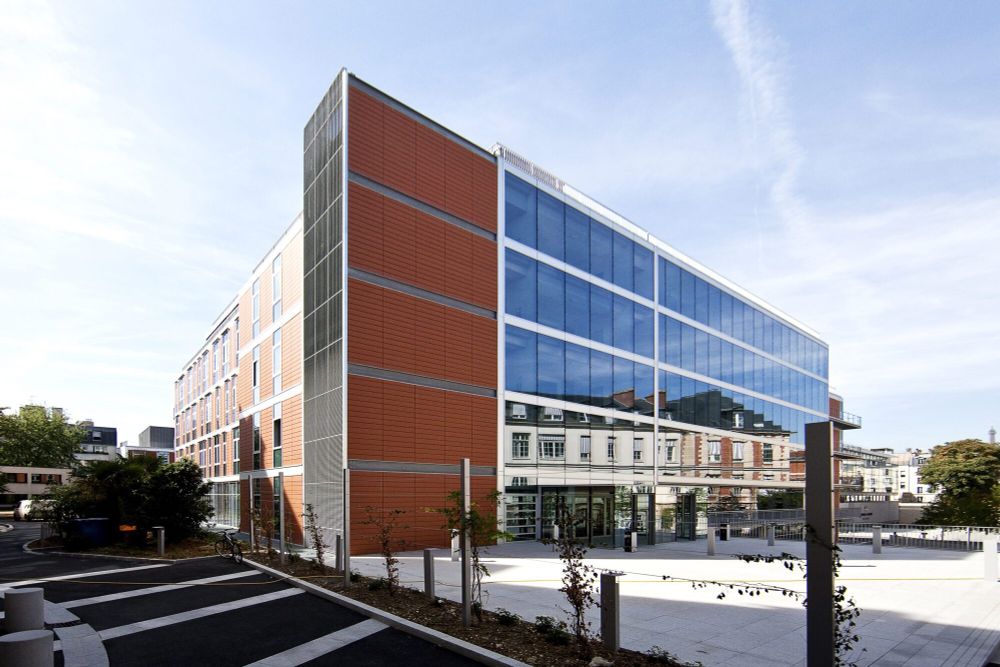
A two year post-doctoral position at the BacterialGenome Plasticity Unit starting October 1st - Research
research.pasteur.fr
July 28, 2025 at 10:30 AM
A 2-year postdoc position in my lab, under the supervision of P-Alex Kaminski, on Z-DNA phages and the benefit given by ZTGC DNA and the replication machinery, with attempt to create a Z based minireplicon
research.pasteur.fr/en/job/a-two...
research.pasteur.fr/en/job/a-two...
Reposted by Marie-Eve VAL
Here's our new broad review on the extended mobility of plasmids, about all mechanisms driving and limiting their transfer. From conjugation to conduction, phage-plasmids to hitchers, molecular to evolutionary dynamics, ecology to biotech. The state of affairs. 1/9 academic.oup.com/nar/article/...
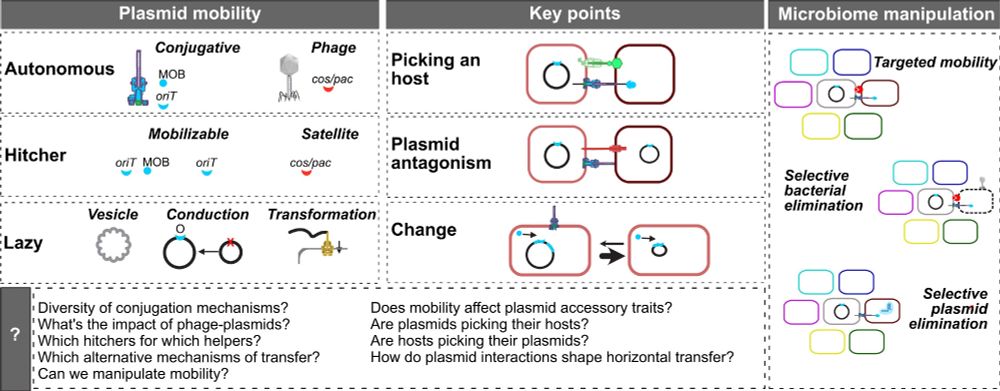
July 23, 2025 at 7:35 AM
Here's our new broad review on the extended mobility of plasmids, about all mechanisms driving and limiting their transfer. From conjugation to conduction, phage-plasmids to hitchers, molecular to evolutionary dynamics, ecology to biotech. The state of affairs. 1/9 academic.oup.com/nar/article/...
Reposted by Marie-Eve VAL
Recently I learnt that EMBL-EBI has a free online course about AlphaFold — how it works, strengths and limitations, how to use it — and it's very good!
There are also little quizzes and interactives.
www.ebi.ac.uk/training/onl...
There are also little quizzes and interactives.
www.ebi.ac.uk/training/onl...
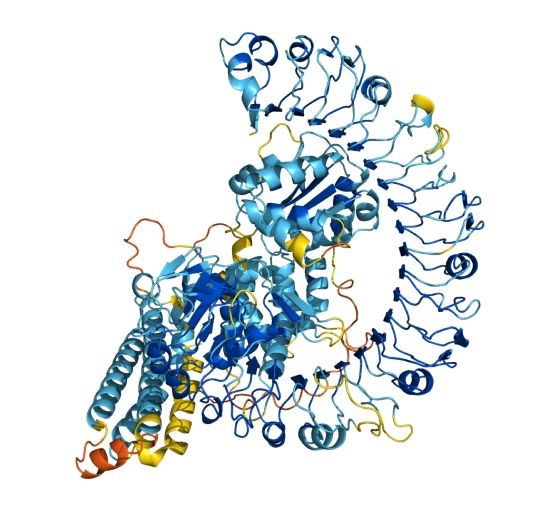
AlphaFold - A practical guide
AlphaFold - A practical guide
www.ebi.ac.uk
July 21, 2025 at 3:33 PM
Recently I learnt that EMBL-EBI has a free online course about AlphaFold — how it works, strengths and limitations, how to use it — and it's very good!
There are also little quizzes and interactives.
www.ebi.ac.uk/training/onl...
There are also little quizzes and interactives.
www.ebi.ac.uk/training/onl...
Reposted by Marie-Eve VAL
#NatMicroPicks
Vibrio in competition! 🦠💉
An orphan T6SS effector in non-toxigenic Vibrio cholerae targets susceptible strains by disrupting ion balance, shaping Vibrio population dynamics and offering a model for precision antimicrobials.
#MicroSky
www.cell.com/cell-host-mi...
Vibrio in competition! 🦠💉
An orphan T6SS effector in non-toxigenic Vibrio cholerae targets susceptible strains by disrupting ion balance, shaping Vibrio population dynamics and offering a model for precision antimicrobials.
#MicroSky
www.cell.com/cell-host-mi...
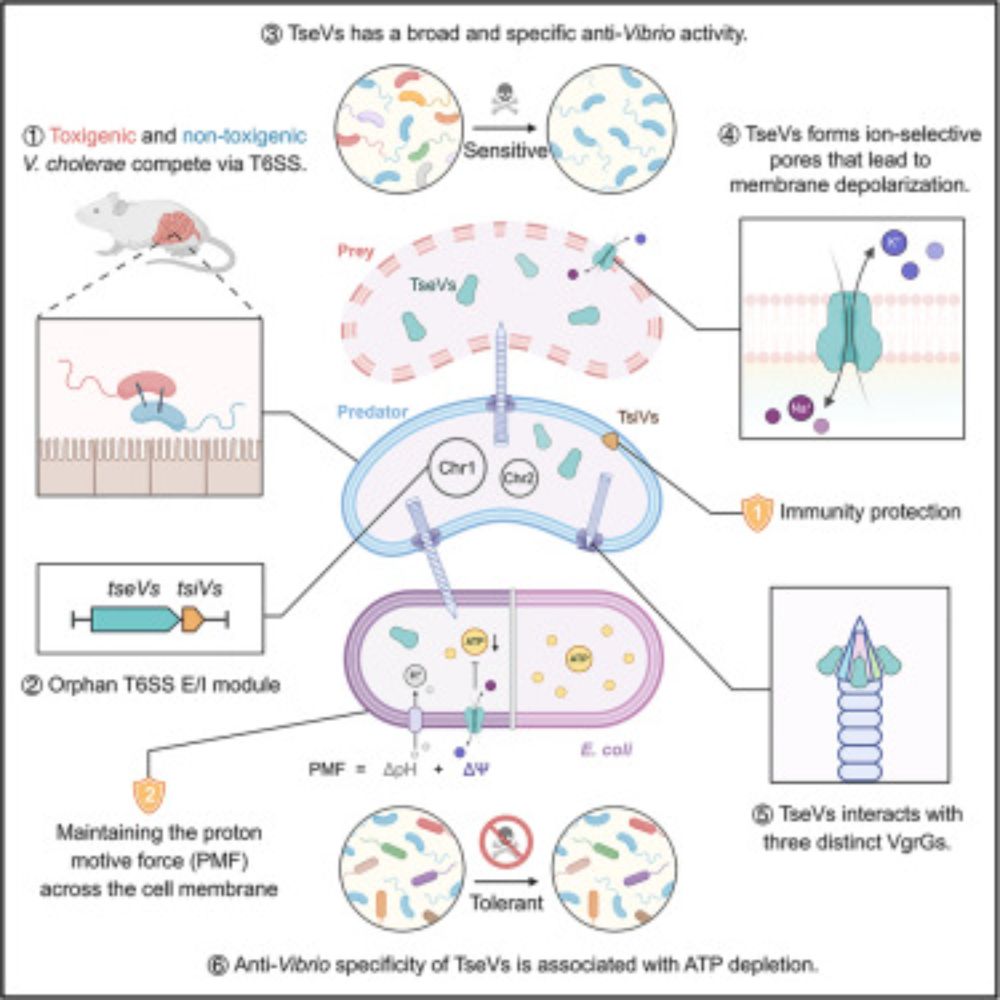
A Vibrio-specific T6SS effector reshapes microbial competition by disrupting Vibrio bioenergetics
Liu et al. report that a Vibrio-specific T6SS effector, TseVs, selectively disrupts
Vibrio bioenergetics while sparing non-target microbes via an immunity-independent
mechanism. This work reveals how ...
www.cell.com
July 4, 2025 at 1:58 PM
#NatMicroPicks
Vibrio in competition! 🦠💉
An orphan T6SS effector in non-toxigenic Vibrio cholerae targets susceptible strains by disrupting ion balance, shaping Vibrio population dynamics and offering a model for precision antimicrobials.
#MicroSky
www.cell.com/cell-host-mi...
Vibrio in competition! 🦠💉
An orphan T6SS effector in non-toxigenic Vibrio cholerae targets susceptible strains by disrupting ion balance, shaping Vibrio population dynamics and offering a model for precision antimicrobials.
#MicroSky
www.cell.com/cell-host-mi...
Reposted by Marie-Eve VAL
York calling! 📣 🧬🧬🧬
Join us at www.biochemistry.org/events-and-t...
⏳⏰ Early bird deadline approaching soon, 16 July! Do not miss out! Half of the talks selected from abstracts.
@damelab.bsky.social @vslioy.bsky.social @graingerlab.bsky.social @biochemsoc.bsky.social @biophychrom.bsky.social
Join us at www.biochemistry.org/events-and-t...
⏳⏰ Early bird deadline approaching soon, 16 July! Do not miss out! Half of the talks selected from abstracts.
@damelab.bsky.social @vslioy.bsky.social @graingerlab.bsky.social @biochemsoc.bsky.social @biophychrom.bsky.social

July 2, 2025 at 5:22 PM
York calling! 📣 🧬🧬🧬
Join us at www.biochemistry.org/events-and-t...
⏳⏰ Early bird deadline approaching soon, 16 July! Do not miss out! Half of the talks selected from abstracts.
@damelab.bsky.social @vslioy.bsky.social @graingerlab.bsky.social @biochemsoc.bsky.social @biophychrom.bsky.social
Join us at www.biochemistry.org/events-and-t...
⏳⏰ Early bird deadline approaching soon, 16 July! Do not miss out! Half of the talks selected from abstracts.
@damelab.bsky.social @vslioy.bsky.social @graingerlab.bsky.social @biochemsoc.bsky.social @biophychrom.bsky.social
Reposted by Marie-Eve VAL
Curious about plasmid biology? Our latest paper is out now in Nature Communications! 🚨
doi.org/10.1038/s414...
We analyzed thousands of diverse bacterial plasmids to shed light for the first time on a key aspect of plasmid biology: plasmid copy number. 1/7 👇
doi.org/10.1038/s414...
We analyzed thousands of diverse bacterial plasmids to shed light for the first time on a key aspect of plasmid biology: plasmid copy number. 1/7 👇
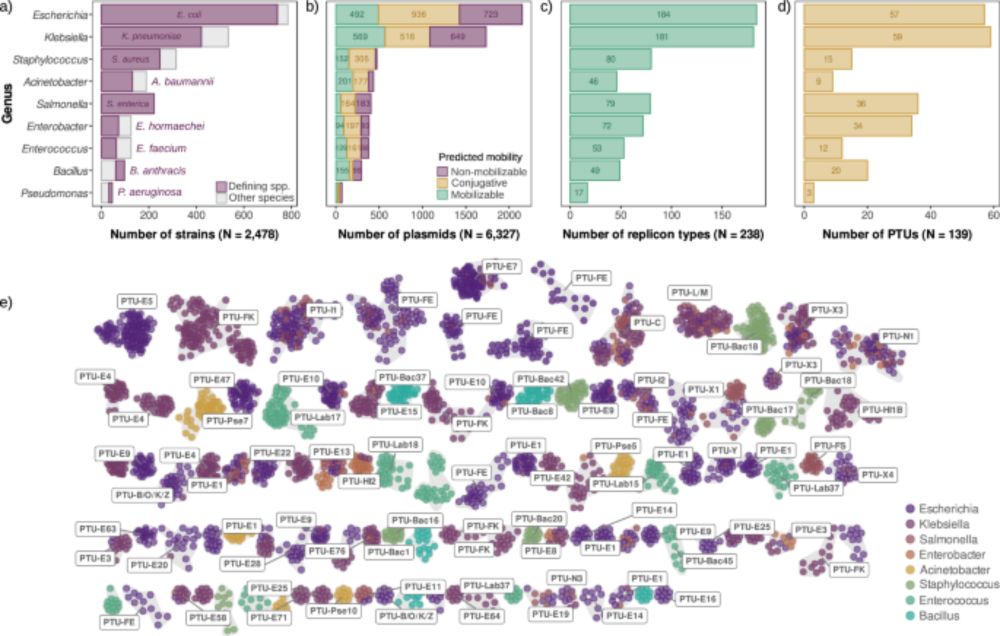
Universal rules govern plasmid copy number - Nature Communications
Plasmids exhibit a broad range of sizes and copies per cell, and these two parameters appear to be negatively correlated. Here, Ramiro-Martínez et al. analyse the copy number of thousands of diverse b...
doi.org
July 2, 2025 at 10:07 AM
Curious about plasmid biology? Our latest paper is out now in Nature Communications! 🚨
doi.org/10.1038/s414...
We analyzed thousands of diverse bacterial plasmids to shed light for the first time on a key aspect of plasmid biology: plasmid copy number. 1/7 👇
doi.org/10.1038/s414...
We analyzed thousands of diverse bacterial plasmids to shed light for the first time on a key aspect of plasmid biology: plasmid copy number. 1/7 👇


